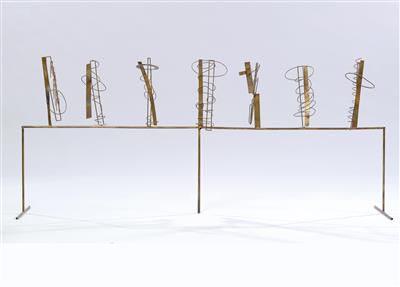Fausto Melotti *

(Rovereto 1901–1986 Milan)
Tema e variazioni XI, 1981 (1984), inscribed Melotti, brass, 65 x 148 x 31 cm, (AR)
Watch Video: Contemporary Art | November 2015 | Giuseppe Uncini and Fausto Melotti
Watch Video: Contemporary Art | November 2015 | Italian Contemporary Art
Provenance:
Marta Melotti Collection
Paolo Baldacci Gallery, New York
VAF Stiftung, Fraunkfurt am Main on loan to Kunst Museum, Bonn (label)
Galleria Fumagalli, Bergamo
European Private Collection
Exhibition:
Sermoneta, Castello Caetani, 20º Festival Pontino di Musica, Fausto Melotti, 13 – 27 June 1984, exh. cat. no. 6 with ill.
New York, Paolo Baldacci Gallery, Fausto Melotti. Anti-sculpture, 4 October - 12 Novmeber 1994, exh. cat. p. 76, no. 23 with ill.
Darmstadt, Institut Mathildenhöhe, Fausto Melotti, Ratio und Strenge - Spiel und Poesie. Retrospektive 1928 – 1986, 28 May - 27 August 2007, Klaus Wolbert (curator), exh. cat. ed. Mazzotta, Milan, no. 106 with ill.
Literature:
Germano Celant, Melotti. Catalogo generale. Sculture, 1973–1986, Electa (Ed.), Milan, 1994, vol. II, p.555, no. 1981 25 with ill.
In an average life of 25,000 days, with one dream per night, every person capitalises on 25,000 dreams. What is left of so many infinite tales? (Fausto Melotti)
They are two seemingly opposite worlds, that of science and logic, and that of poetry and emotional interpretation. Fausto Melotti’s art derives from a refined combination of rationality and imagination: between intellectual exercise and creative freedom, the artist is capable of harmonising a rigorous search for order and a moderate amount of playfulness and fairy-tale bizarreness.
His entire artistic activity is clearly influenced by the scientific knowledge he accumulated as an electric engineer, and by his passion for music, which remained a constant element throughout his life. Geometrical figures and musical canons became the characteristic tenets of his poetics.
Melotti was born in Rovereto in 1901 and, after a variety of experiences, found his language and source of inspiration in the thriving artistic milieu of Milan in the 1930s, where the then newly born Galleria del Milione displayed the works by representatives of the international avant-garde movements (Léger, Vordemberge, Kandinsky, Albers) as well as their Italian counterpart (Veronesi, Soldati, Licini, Reggiani, Radice, Fontana).
His early works, expressing a form of abstraction that was influenced by architects such as Terragni, Sartoris, Le Corbusier, were for the most part destroyed by the bombings during the war, the horrors of which caused Melotti to distance himself from the idealised abstraction of his early years and to remain silent for about two decades.
When he returned to his inventions in 1959, he created works in which the initial geometric abstraction was enriched by a new narrativity that was dream-like and poetic at once.
During that period he started working at thread-like sculptures, almost two-dimensional and free from the burden of matter, yet capable of conquering space with elegant discretion and of building magical environments, theatrical spaces, which can be linked to a certain extent to the series centred on the ‘teatrini’ [little theatres] in the 1950s.
As a leading figure in 20th-century Italian sculpture, Melotti was a mature artist, but also innovative and ironic, capable of merging air and matter, full and empty spaces, and of harmoniously occupying spaces in a refined mixture of planned research and poetic lyricism.
This practice clearly evinces the vast technical knowledge he acquired during his study at the Accademia in Brera under the guidance of Adolfo Wildt.
I use metal because it brings me close to drawing: with metal I can draw in space.
(F. Melotti, in “Melotti”, exhibition catalogue, Rome, Galleria d’Arte Moderna, 1983, p. 10).
By soldering and slimming down metals until they become vibrant in their litheness, Melotti realises a very personal idea of sculpture that is reminiscent of Mirò’s forms, Calder’s movement and Kandinsky’s lines, to whom he was especially close in his attempt to offer a visual translation of musical scores.
The sculpture Tema e variazioni XI, 1981 (1984) is made of brass, a light and malleable material, and presents itself like a fantastical apparition, a stage on which subtle and lithe metallic figures shine in their aerial quality when light breaks upon them. The artist masterfully bends, cuts and solders metal, a material that goes back to his experience as an electronic engineer, and transforms it, producing a result of extreme lightness.
His forms seem to be drawn in the air, they give space a rhythmic pulse and create a visual musical score.
Expert: Alessandro Rizzi
 Alessandro Rizzi
Alessandro Rizzi
+39-02-303 52 41
alessandro.rizzi@dorotheum.it
25.11.2015 - 18:00
- Dosažená cena: **
-
EUR 271.400,-
- Odhadní cena:
-
EUR 110.000,- do EUR 160.000,-
Fausto Melotti *
(Rovereto 1901–1986 Milan)
Tema e variazioni XI, 1981 (1984), inscribed Melotti, brass, 65 x 148 x 31 cm, (AR)
Watch Video: Contemporary Art | November 2015 | Giuseppe Uncini and Fausto Melotti
Watch Video: Contemporary Art | November 2015 | Italian Contemporary Art
Provenance:
Marta Melotti Collection
Paolo Baldacci Gallery, New York
VAF Stiftung, Fraunkfurt am Main on loan to Kunst Museum, Bonn (label)
Galleria Fumagalli, Bergamo
European Private Collection
Exhibition:
Sermoneta, Castello Caetani, 20º Festival Pontino di Musica, Fausto Melotti, 13 – 27 June 1984, exh. cat. no. 6 with ill.
New York, Paolo Baldacci Gallery, Fausto Melotti. Anti-sculpture, 4 October - 12 Novmeber 1994, exh. cat. p. 76, no. 23 with ill.
Darmstadt, Institut Mathildenhöhe, Fausto Melotti, Ratio und Strenge - Spiel und Poesie. Retrospektive 1928 – 1986, 28 May - 27 August 2007, Klaus Wolbert (curator), exh. cat. ed. Mazzotta, Milan, no. 106 with ill.
Literature:
Germano Celant, Melotti. Catalogo generale. Sculture, 1973–1986, Electa (Ed.), Milan, 1994, vol. II, p.555, no. 1981 25 with ill.
In an average life of 25,000 days, with one dream per night, every person capitalises on 25,000 dreams. What is left of so many infinite tales? (Fausto Melotti)
They are two seemingly opposite worlds, that of science and logic, and that of poetry and emotional interpretation. Fausto Melotti’s art derives from a refined combination of rationality and imagination: between intellectual exercise and creative freedom, the artist is capable of harmonising a rigorous search for order and a moderate amount of playfulness and fairy-tale bizarreness.
His entire artistic activity is clearly influenced by the scientific knowledge he accumulated as an electric engineer, and by his passion for music, which remained a constant element throughout his life. Geometrical figures and musical canons became the characteristic tenets of his poetics.
Melotti was born in Rovereto in 1901 and, after a variety of experiences, found his language and source of inspiration in the thriving artistic milieu of Milan in the 1930s, where the then newly born Galleria del Milione displayed the works by representatives of the international avant-garde movements (Léger, Vordemberge, Kandinsky, Albers) as well as their Italian counterpart (Veronesi, Soldati, Licini, Reggiani, Radice, Fontana).
His early works, expressing a form of abstraction that was influenced by architects such as Terragni, Sartoris, Le Corbusier, were for the most part destroyed by the bombings during the war, the horrors of which caused Melotti to distance himself from the idealised abstraction of his early years and to remain silent for about two decades.
When he returned to his inventions in 1959, he created works in which the initial geometric abstraction was enriched by a new narrativity that was dream-like and poetic at once.
During that period he started working at thread-like sculptures, almost two-dimensional and free from the burden of matter, yet capable of conquering space with elegant discretion and of building magical environments, theatrical spaces, which can be linked to a certain extent to the series centred on the ‘teatrini’ [little theatres] in the 1950s.
As a leading figure in 20th-century Italian sculpture, Melotti was a mature artist, but also innovative and ironic, capable of merging air and matter, full and empty spaces, and of harmoniously occupying spaces in a refined mixture of planned research and poetic lyricism.
This practice clearly evinces the vast technical knowledge he acquired during his study at the Accademia in Brera under the guidance of Adolfo Wildt.
I use metal because it brings me close to drawing: with metal I can draw in space.
(F. Melotti, in “Melotti”, exhibition catalogue, Rome, Galleria d’Arte Moderna, 1983, p. 10).
By soldering and slimming down metals until they become vibrant in their litheness, Melotti realises a very personal idea of sculpture that is reminiscent of Mirò’s forms, Calder’s movement and Kandinsky’s lines, to whom he was especially close in his attempt to offer a visual translation of musical scores.
The sculpture Tema e variazioni XI, 1981 (1984) is made of brass, a light and malleable material, and presents itself like a fantastical apparition, a stage on which subtle and lithe metallic figures shine in their aerial quality when light breaks upon them. The artist masterfully bends, cuts and solders metal, a material that goes back to his experience as an electronic engineer, and transforms it, producing a result of extreme lightness.
His forms seem to be drawn in the air, they give space a rhythmic pulse and create a visual musical score.
Expert: Alessandro Rizzi
 Alessandro Rizzi
Alessandro Rizzi
+39-02-303 52 41
alessandro.rizzi@dorotheum.it
|
Horká linka kupujících
Po-Pá: 10.00 - 17.00
kundendienst@dorotheum.at +43 1 515 60 200 |
| Aukce: | Současné umění |
| Typ aukce: | Salónní aukce |
| Datum: | 25.11.2015 - 18:00 |
| Místo konání aukce: | Wien | Palais Dorotheum |
| Prohlídka: | 14.11. - 25.11.2015 |
** Kupní cena vč. poplatku kupujícího a DPH
Není již možné podávat příkazy ke koupi přes internet. Aukce se právě připravuje resp. byla již uskutečněna.
